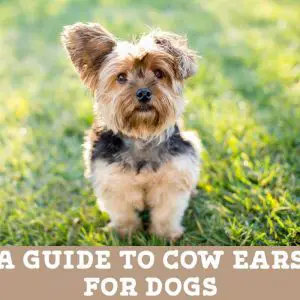Lamb heart for dogs can be of interest if you’re interested in feeding raw food as well as if you’re you looking for a meaty treat which is full of delicious nutrients.
But you might be wondering if there are any risks associated with feeding lamb hearts. Or you might wonder how to prepare them and how many to give your dog. In this article we will discuss all there is to know about lamb hearts.
Key facts
Lamb hearts can be purchased whole and raw, or as freeze-dried cubes.
Lamb hearts are suitable to feed as part of a raw diet or as a highly palatable treat.
Due to the richness of lamb hearts, they can cause diarrhoea if introduced too quickly.
Lamb hearts are nutritious, high in protein, and full of nutrients which boost general health.
Great alternatives to lamb hearts are other types of hearts, such as ox heart or chicken heart, or beef tendons.
What Is Lamb Heart for Dogs?
Lamb hearts are as they sound; the hearts of lambs. You can buy them in a variety of forms and from various different places too. Most commonly, lamb hearts come whole, from a butcher or online retailer. They will usually be the size of your fist, and covered in a layer of fat. The vessels going in and out of them are not usually attached. This type of lamb heart is usually used for raw feeding and you don’t have to do anything to them, as cooking can decrease their nutritional value.
You can also buy lamb hearts in chunks which have been freeze-dried. They are healthy nutritional treats which your dog is bound to go crazy for. These types of lamb hearts can be used as a treat in raw fed and kibble fed dogs, especially if you want to provide a treat which is simply one ingredient and not comprised of fillers and preservatives.
Lamb hearts can come from lambs anywhere in the world, however if you’re buying from your butcher, there’s a good chance that the lambs have been locally raised. It’s important to find out whether they are organic and free-range, as this ensures they have been well looked after and are not full of chemicals and antibiotics.
Benefits of Lamb Heart Dog Treats
Key benefits
Promotes Muscle Growth
Great source of protein which supports healthy muscle growth.
Brain Food
Lamb heart contains loads of vitamins and minerals promoting healthy organs, including the brain.
Lamb hearts are extremely healthy, and full of essential nutrients. However, they are very rich and as a result should not be fed excessively.
If your dog isn’t raw fed, then this is not something you need to worry about. As long as heart (be it fresh or freeze-dried) is fed in moderation as a treat, and your dog is otherwise receiving a balanced commercial diet, then lamb heart can be a great option to provide some healthy, delicious food for your dog.
So, what makes it so healthy? Lamb heart is rich in vitamins A, C and B complex, as well as thiamine, zinc, manganese, selenium and copper. These are all essential minerals and vitamins which contribute to healthy organs, optimal brain function, efficient metabolism and boosted immunity. Lamb hearts are also high in protein, which is essential for muscle growth and the production of enzymes and hormones. Heart is by no means a complete, nutritionally balanced food source, but as you can see, it certainly is an excellent source of many nutrients which help boost your dog’s overall wellbeing.
The downside is that lamb hearts are relatively fatty, and rich in cholesterol at 267mg per portion. However, if freeze-dried, sometimes this fat is trimmed off and doesn’t make up such a high percentage.
raw feeding
MUSCLE MEAT OR ORGAN?
Most people who buy lamb hearts have the intention of raw feeding. There is some controversy as to whether you should consider heart meat (from any animal) a muscle meat or an organ.
Organs should not comprise more than 10% of the diet, of which liver should make up approximately half the organ requirement, and secretory organs the other half. While heart is technically an organ, it is also a muscle.
Most people agree that it should only be fed in small amounts like organs (i.e. not more than 10% of your dog’s requirement), yet it doesn’t have to fall within the organ portion of the diet. It should also be followed with a bone meal next and not a muscle meat or organ meal.
Nutritional Information for Lamb Hearts
The nutritional constituents of lamb heart vary widely, especially between raw and freeze-dried products. An approximate guaranteed analysis looks something like this:
Nutrition
Note: The percentages don’t add up to 100% as they are averages from multiple sources of data.
As you can see from the figures, fresh raw heart contains a significant amount of moisture, meaning you need to feed a lot less freeze-dried heart to give your dog the same amount of protein.
Not only are hearts great as part of a healthy diet, they are also perfect as a high-value reward for your dog. They are incredibly palatable and it’s rare for a dog not to love the taste of both fresh and freeze-dried options.
It’s important to note that you can easily, and quickly, give your dog a lot of calories with freeze-dried heart (or any freeze-dried food for that matter). Nevertheless, it doesn’t mean it’s not healthy. It just needs to be fed in moderation, especially since it is also a very rich organ meat.
Feeding Guide
This very much depends on if you are feeding it as part of a raw diet or as a treat. An ideal weight dog being fed a raw food diet should receive a total of 2-3% of their bodyweight in raw food. This includes muscles, bones and organs. Of this total, lamb heart shouldn’t constitute more than about 10% of it.
As for dried lamb hearts, for an average sized dog, a large cube can be given a few times a week as a treat.
These are only suggestions and every dog is different. Therefore you should consult the advice of your veterinary nutritionist to ensure your dog is receiving a perfectly balanced diet for his individual needs and life-stage. This is especially important for raw fed dogs.
There are a few exceptions though. Lamb heart is extremely rich, so it is important not to initially feed the full amount the first time round. It must be slowly introduced, both as a meal or as a treat. In addition to that, lamb heart is fatty, and therefore should be avoided or only fed in very small quantities to dogs who have fat-triggered conditions, such as pancreatitis, exocrine pancreatic insufficiency, and inflammatory bowel disease.
Disadvantages & Risks of Lamb Hearts for Dogs?
Very Safe
There’s nothing inherently risky about lamb hearts for dogs. Because they are rich you shouldn’t introduce them into a diet too quickly. And also be aware of hygiene to avoid food poisoning.
Generally, hearts are relatively safe to feed dogs. There are potentially a few risks associated with lamb hearts, but they can easily be mitigated.
Lamb hearts are rich, and so if you introduce them too quickly they can cause your dog to have a gastrointestinal upset. It is easily avoided by gradually increasing the quantity of heart you give your dog over the course of several weeks.
In addition to that, raw lamb heart can carry bacteria. This is the case for many raw foods, and most dogs have no issue with it. However, to prevent food poisoning in both your dog and yourself, you should keep the lamb heart frozen until you defrost to feed it the next day. It’s important to practice good hygiene too, by washing your hands and cleaning the areas where the heart has been.
You should also avoid feeding lamb hearts to your dog if they are obese or have a fat-triggered condition, such as pancreatitis, exocrine pancreatic insufficiency, and inflammatory bowel disease. The high fat content of lamb hearts can worsen these conditions.
Finally, you should also avoid feeding lamb hearts to your dog if they are allergic to lamb protein. Hearts are high in protein, and are therefore likely to trigger an allergic reaction.
Lamb Hearts for Puppies

Small amounts of lamb heart can be fed to puppies of any age. Freeze-dried lamb heart is incredibly tasty for dogs, and therefore is a great incentive for your puppy when training him.
You can also give small amounts of raw heart as a training treat, however, we do not recommend feeding raw food diets to puppies. Puppies need a fine balance of calcium and phosphorus in their diets. An imbalance can result in life-changing bone development abnormalities. It is extremely easy to upset the fine balance of these minerals by feeding raw food. Therefore, it’s best to stick to nutritionally balanced commercial puppy foods, until at least your puppy is fully grown.
Alternatives to Lamb Hearts
Thinking about lamb hearts but not quite sold on them yet? Why not try one of these alternatives?
- Chicken hearts: Chicken hearts are very nutritious and can be fed as part of a raw diet. They are great for small dogs, however they are a bit too small for large dogs.
- Ox hearts: Ox hearts are much like lamb hearts, and are great for large dogs. They are full of nutrients, especially immune boosting anti-oxidants, and can be purchased in jerky strips or fresh.
- Beef tendons: If you’re wanting a high protein treat, beef tendons are a great alternative. They are also lower in fat, and improve dental and joint health.
FAQs
Lamb hearts are extremely healthy, and full of essential nutrients. However, they are very rich and as a result should not be fed excessively.
A normal, raw-fed dog should receive a total of 2-3% of their bodyweight in raw food. This includes muscles, bones and organs. Of this total, lamb heart shouldn’t constitute more than about 10% of it. For dried lamb heart treats you can feed a medium-sized dog a large cube a few times a week as a treat.
Generally, hearts are relatively safe to feed dogs. However, lamb hearts are rich and so if you introduce them too quickly they can cause your dog to have a gastrointestinal upset. It is easily avoided by gradually increasing the quantity over time.
All raw food can be unpleasant and unhygienic in the house, but how about freeze-dried lamb heart treats? These treats do have a distinct smell to them, but they are not overpowering. They are also not particularly greasy, especially when the fat has been trimmed off. Therefore there are not many off-putting qualities about these treats which will make you want to ban your dog from the house to eat the treat!
Lamb hearts can cause diarrhoea due to their richness. This is particularly common in cases where it has been introduced too quickly, and can be easily avoided by only initially offering small amounts of lamb heart.
In addition to that, lamb hearts can carry bacteria which can cause digestive upsets. Bacterial growth is slowed or halted when raw food is frozen, and therefore it’s important to keep it cold at all times. You should thaw it in your fridge the day before giving it to your dog.
Lamb hearts don’t carry the risk of causing blockages because they are completely digestible in the stomach. They are also relatively easy to chew and not hard or sharp like bone can be.
Lamb hearts are by-products of the meat industry and are often thrown away. Occasionally they are made into dog food.
Many butchers will put them in their waste-bin and not put them out for sale. However it’s always worth asking if they have any which you can buy, and you might find they have some out the back of the butchery.









